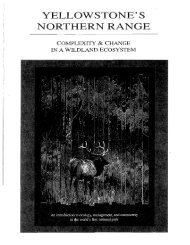Predictive models of whitebark pine mortality from mountain pine ...
Predictive models of whitebark pine mortality from mountain pine ...
Predictive models of whitebark pine mortality from mountain pine ...
You also want an ePaper? Increase the reach of your titles
YUMPU automatically turns print PDFs into web optimized ePapers that Google loves.
500 D.L. Perkins, D.W. Roberts / Forest Ecology and Management 174 (2003) 495–510<br />
10.2 cm (4.0 in.) were recorded. Additionally, the<br />
first trees north and south on a clockwise arc <strong>from</strong> plot<br />
center were cored with an increment borer for age<br />
determination. To maximize the precision <strong>of</strong> age<br />
estimates, trees were cored close to ground level,<br />
generally 30–35 cm (12–14 in.) <strong>from</strong> the ground surface.<br />
Individual trees were recorded as attacked and<br />
killed by <strong>mountain</strong> <strong>pine</strong> beetles (ca. 1930) versus not<br />
attacked; stands were recorded as attacked (15%<br />
<strong>mortality</strong>) versus not attacked. Trees that died <strong>from</strong><br />
unknown causes, were older than ca. 1930 beetlekilled<br />
trees or were recently killed by beetles (within<br />
last 10 years) were recorded.<br />
2.3. Analyses<br />
To reconstruct the stand structure prior to the<br />
<strong>mountain</strong> <strong>pine</strong> beetle epidemic, the diameter <strong>of</strong> trees<br />
ca. 1930 (DBH30) was estimated <strong>from</strong> live cored trees<br />
as<br />
DBH30 ¼ DBH98 2RI<br />
where DBH98 was the diameter at breast height<br />
recorded in 1998 and RI was the radial increment<br />
measured to the nearest 0.25 cm (0.10 in.) along the<br />
increment core <strong>from</strong> the 1930 through the 1998 annual<br />
ring. To maximize precision <strong>of</strong> radial increment estimates<br />
and because tree-ring widths are small, all<br />
increment cores were measured under a microscope.<br />
Trees with reconstructed DBH30 less than 10 cm<br />
(4.0 in.) were not used in further analyses and reduced<br />
the sample size to 134 trees. From this subset we<br />
developed a regression model to calculate the DBH30<br />
<strong>of</strong> all live trees sampled but not cored:<br />
p<br />
DBH30 ¼ a þ b ffiffiffiffiffiffiffiffiffiffiffiffiffiffiffi 2<br />
DBH98<br />
Because the width <strong>of</strong> a tree-ring in 1998 may be<br />
considered a function <strong>of</strong> linear increase in area <strong>of</strong><br />
the ring added in 1998, modeling the DBH ca. 1930<br />
was accomplished by fitting the model in the square<br />
root scale. The regression equation, standard diagnostics<br />
and plots <strong>of</strong> residuals versus predicted values were<br />
calculated using the s<strong>of</strong>tware Mathematica version 3.0<br />
(Wolfram, 1996). Diameters <strong>of</strong> beetle-killed trees<br />
that died in the epidemic and were recorded in<br />
1998 were used for the ca. 1930 (preattack) diameter<br />
estimates. The reconstructed diameters were then used<br />
to compute basal area <strong>of</strong> the tree ca. 1930 (batr30),<br />
basal area per 0.04 ha ca. 1930 (baplt30), and trees per<br />
0.04 ha ca. 1930 (tplt30). Additionally we recorded<br />
the number <strong>of</strong> stems in a tree cluster (clump) as a<br />
potential predictor variable. Multiple stem growth<br />
forms called tree clusters (Tomback et al., 1990) occur<br />
because multiple seeds are cached by Clark’s nutcrackers<br />
(Lanner, 1980, 1982; Hutchins and Lanner,<br />
1982; Tomback, 1982). They may be composed <strong>of</strong><br />
single-trunk individuals, single genet multi-trunk<br />
forms, or multiple-genet tree clusters (Linhart and<br />
Tomback, 1985; Furnier et al., 1987). Our metrics<br />
on a 0.04 ha plot therefore characterize the local, treelevel<br />
environment <strong>of</strong> a tree (or tree cluster), and the<br />
number <strong>of</strong> stems ca. 1930 (nstms) characterizes the<br />
structure <strong>of</strong> a tree cluster. Stand-level attributes<br />
including stand density index, SDI, (sdi) (Reineke,<br />
1933; Long and Daniel, 1990), quadratic mean diameter<br />
(dq), basal area (ba), and mean basal area (mba)<br />
were calculated ca. 1930 and 1998 for all 14 stands.<br />
Stand-level and tree-level metrics and physical site<br />
attributes (elevation, aspect and slope) were used for<br />
two fundamental analyses: (1) stand-level metrics were<br />
used for a stand-level logistic regression model to<br />
explain the relative probability <strong>of</strong> attack as a function<br />
<strong>of</strong> stand-level variables; (2) tree-level metrics <strong>of</strong><br />
attacked stands constituted the set <strong>of</strong> independent variables<br />
used in a 10-fold cross-validated logistic regression<br />
model for explaining the relative probability <strong>of</strong><br />
individual tree attack given that the stand was attacked.<br />
The utility <strong>of</strong> logistic regression to describe a<br />
discrete event as a function <strong>of</strong> independent site and<br />
stand variables is well established for forest tree<br />
<strong>mortality</strong> (Hamilton, 1974, 1986; Hamilton and<br />
Edwards, 1976; Reed et al., 1982; Berryman, 1986).<br />
In logistic regression the dependent or response variable,<br />
tree survivorship status is dichotomous taking the<br />
value <strong>of</strong> zero or one. The response distribution for<br />
logistic regression is the binomial distribution established<br />
through a logit link function that relates the log<br />
<strong>of</strong> the odds <strong>of</strong> attack with the linear predictor <strong>of</strong><br />
independent variables (Hastie and Pregibon, 1992).<br />
The model can be expressed as<br />
<br />
p<br />
ln ¼ b 0 þ b 1 x 1 þ b 2 x 2 þþb n x n<br />
1 p<br />
where p is the probability <strong>of</strong> attack, x 1 ; x 2 ; ...; x n are the<br />
predictor variables and b 0 ; b 1 ; ...; b n are coefficients















